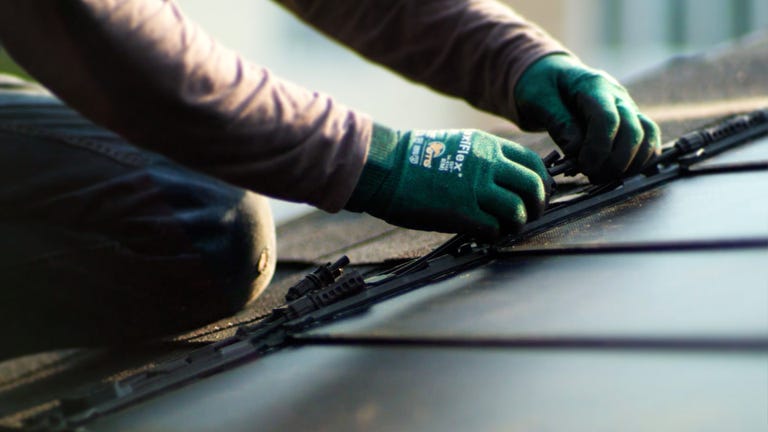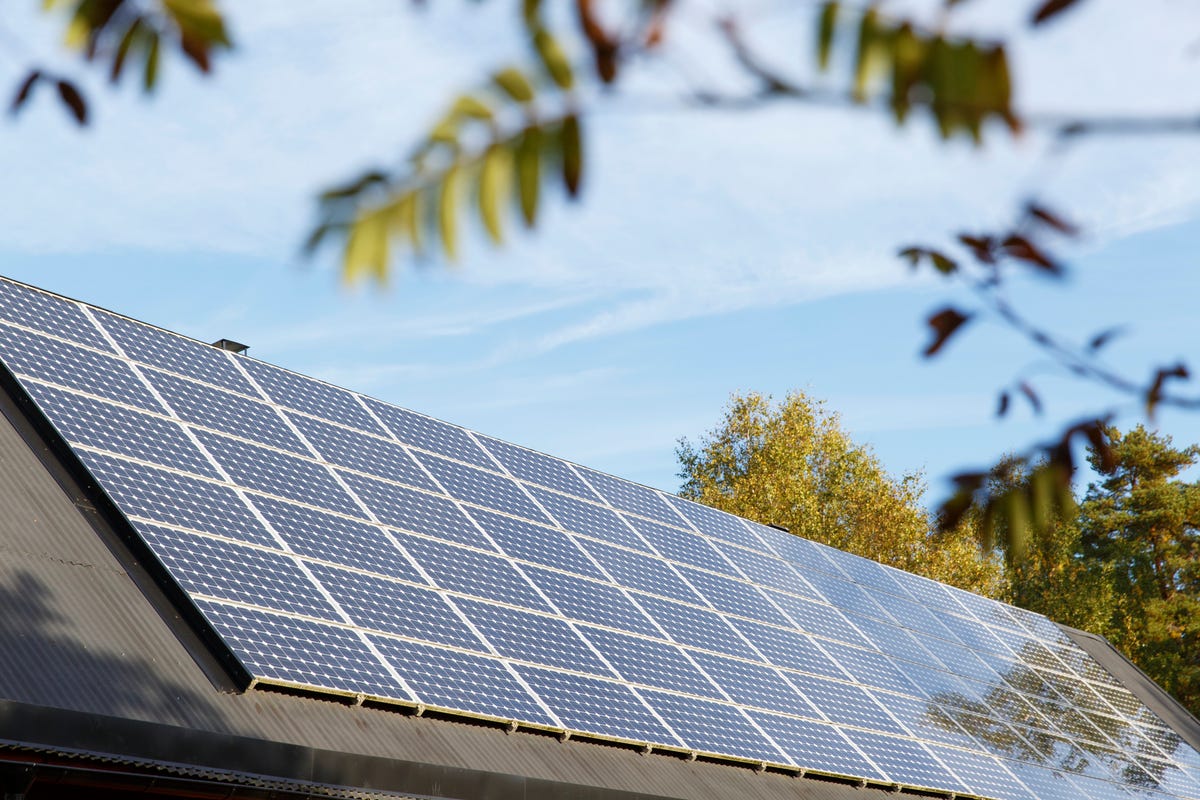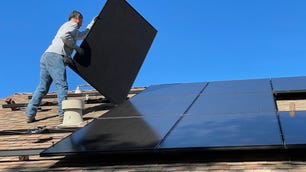If you’re considering solar panels for your home, you might be excited about the opportunity to use more clean energy, be a bit more self-sufficient or reduce your energy bill.
You probably aren’t excited about the cost.
Though prices have dropped dramatically over the last decade (barring a recent but apparently temporary increase thanks to inflation and supply chain issues), a rooftop solar system will still cost you thousands. The national average cost for solar is $3.30/watt, according to a report from Wood Mackenzie and the Solar Energy Industry Association. That would be about $16,500 for a five kilowatt system.
It’s certainly not pennies, but it’s a purchase that could pay for years to come in lower utility bills and a lower carbon footprint. To determine which financing option is best for you, figure out your budget and your priorities.
“Is it the environmental impact or money savings, or both?” said Krystal Persaud, co-founder of Wildgrid, a company that helps people adopt clean energy at home.
No matter your reasons for going with solar panels, you’ll need to pay for them. Here’s how you can.
Buying solar panels with cash
It’s true that cash is king. If you have that money sitting in the bank, just like with any other home improvement projects, you might want to pay for solar panel installation in full. The major benefit is that you won’t have to worry about monthly payments and paying any interest or fees. However, it will take some time to break even. For instance, if you bought a solar panel system for $30,000 that completely offsets your average annual energy usage of $3,000, it will take 10 years to recoup the cost.
“Because paying for solar with cash is for the wealthiest people, it’s not the most common route,” Persaud said. “But it is the most affordable way in that you don’t owe any interest. You pay for it and you’re done, and the extra energy you make is yours.”

Watch this: New Solar Shingles You May Not Even Notice
Buying solar panels with a solar loan
While this option might be more common for homeowners who want to go solar, it is also a little more tricky to figure out. That’s because solar loans aren’t as common as home equity lines of credit or personal loans, and the rates and terms aren’t as transparent.
According to the Clean Energy States Alliance’s homeowner’s guide to solar financing (PDF), solar loans are usually from solar companies themselves or third-party financial institutions that work with solar installers. Interest rates can vary widely based on a number of factors that include:
- Unsecured vs. secured loan
- Loan length
- Lending institution
- Location
- Down payment
- Credit score
- Loan size
- Prime rate set by the federal government at the time of servicing
The good news with financing your home solar panels is that you can still take advantage of any solar energy and rebates. However, there are some things to watch out for. For instance, some loan agreements include interest-only payments for the first year in order to give you time to get the rebates and incentives to put toward the loan. While this might make for low monthly payments to start, the loan payments may be higher for the rest of the loan.
Also, part of that loan amount will be the salesperson’s commission.
“In that, say, $20,000 quote, look at the commission, which can be as high as $5,000,” Persaud said. “And always negotiate. Your discount might come from their commission, and the salesperson might be willing to take it out of their cut to get to close the deal.”
Leasing solar panels
Leasing or taking on a power purchase agreement might be another affordable way to power your home with renewable energy. A power purchase agreement is like a lease, except that your monthly payments are for the electricity generated by your panels, not the panels themselves. Monthly payments with a power purchasing agreement will vary. Lease payments are largely set.
A major draw to these options is that they don’t require you to pay anything up front. The solar company owns the system and is responsible for maintaining it. However, you won’t get any tax incentives or rebates. If you’re on a power purchasing agreement, watch for a clause that states you’re on the hook for paying for any “net energy” that your solar system generates.
“A lease might be more common for folks who aren’t working anymore or are retired,” says Persaud. “They wouldn’t need to benefit from the federal tax credit because they don’t have taxable income. Plus, they might be on a fixed income.”
Cash-out refinance or HELOC
You can also tap into your home’s equity to pay for solar panels. Two common ways to do this is through a cash-out refinance or a home equity line of credit.
Jump-start your solar journey by exploring Home Equity & HELOC rates from multiple lenders
With a cash-out refinance, you take out a larger mortgage and pocket the difference. The main advantages are that the interest rates are typically lower than those of a credit card or personal loan and you can expect steady, predictable monthly payments.
You are eligible for the federal tax credit. Plus, since you’re using the funds for a home improvement project, you might be able to get an additional tax deduction when you sell your house. The downside with a cash-out refinance is that you’re increasing the amount of your mortgage payments. Plus, since interest rates have climbed recently, there’s a high likelihood you would refinance at a higher rate than when you first took out your mortgage.
A HELOC works like a credit card in that you’re given a line of credit with a certain limit, and can borrow from your line of credit and pay it back as you go. HELOCs typically have a draw period, which is typically five or 10 years. And like a cash-out refinance, you’ll be eligible for a tax deduction if you use the loan money for a home solar system.
With either option, while you might enjoy a lower interest rate than with a solar loan, you are taking on more debt that’s tied to your housing and equity. Plus, you usually need at least 15% of your home paid off.
“If you’re a new homeowner, and you don’t own a lot of the equity, it might not be worth it to put on more debt,” says Persaud.
How tax credits affect how you pay for solar panels
A major perk is that you can enjoy any tax rebates and incentives. For instance, the federal government is offering a 30% tax credit for solar systems installed through 2032. This is applied for the total cost of your system, which includes the cost of the panels, any labor costs, such as installation, and home batteries. A tax credit will lower the amount you owe in taxes; the government won’t send you a check.
Let’s say you’re paying in cash or financing your solar panels. And the cost for your solar panel installation is $30,000. With the 30% tax credit, your taxable income will be lowered by $9,000.
On top of the federal tax credit, there might be state-level incentives for going solar. Net metering is a billing agreement between solar energy producers — like you, after you have solar panels installed — and a utility company where solar owners earn credits for sending their surplus energy to the grid. According to SaveOnEnergy, 38 states have net metering policies.
Whatever financing option you land on, it’s important to look at your average monthly energy costs and how much you’d be paying if you take out a loan or sign a lease.
“You want the numbers to be as close as possible,” says Persaud. “Try to negotiate so that the numbers are as close as possible, and your monthly payment for solar is the same.”
Plus, beware of scams.
“A good salesperson won’t be afraid of answering the questions you have,” says Persaud. “To make sure you don’t overpay, take all the time you need, compare quotes with friends and check what’s the normal cost for your area.”
Other government help for buying solar panels
Beyond the federal solar tax credit, the federal government (and sometimes your state) can help with a couple of other financing options.
A HomeStyle energy mortgage from Fannie Mae allows you to add the cost of a solar project into your new or refinanced mortgage. The Federal Housing Administration offers similar additions to mortgages. The amount of money you can borrow is determined based on the value of your home.
One of the advantages of an Energy Efficient Mortgage, as they’re known, is that you’re borrowing money once instead of twice. That means you only pay one set of loan costs and fees, and you can pay it back over 30 years, instead of 10 or 15 as can be the case with other solar loans. This keeps your monthly payment low. Not every lending institution offers loans from these programs and the borrowing process can be complicated.
“They tend to be more complicated, because you need to make so many phone calls to reach the right people,” said Roger Horowitz, director of co-ops at Solar United Neighbors, a nonprofit and advocacy group helping people adopt solar in 11 states. That can place an extra burden on people who have fewer financial resources, the people the program is meant to help. It’s important to work with an institution who knows how to navigate these systems, Horowitz said.
An Energy Efficient Mortgage can be used for other energy-saving equipment in addition to solar panels, such as new insulation, new windows and doors, smart thermostats or water efficiency improvements. Whatever the upgrade, it must be cost-effective, which means it needs to save more money over its lifetime than it costs. For most places in the country, solar panels are sure to satisfy that requirement.

Explore your options for reducing the price of your solar panels.
Another option is Property Assessed Clean Energy, which deserves a brief mention despite only being available to residential customers in California, Florida and Missouri. Working with a local PACE office, you can finance your solar panels and pay back the loan over a longer period of time through an additional charge on your taxes. In theory, this makes large purchases more affordable, though early iterations of the program have actually buried some low-income homeowners with debt and the possibility of foreclosure. New regulations passed by state legislatures could fix this problem.
Which solar financing option is best?
The best solar financing option will be the one that best fits your needs. Take careful stock of your finances, energy usage and your long-term plans to stay in your house. And, just like you should get multiple quotes before purchasing solar panels, you should shop around for financing. In some cases, finding the best solar financing deal just requires a bit of extra legwork.





















+ There are no comments
Add yours